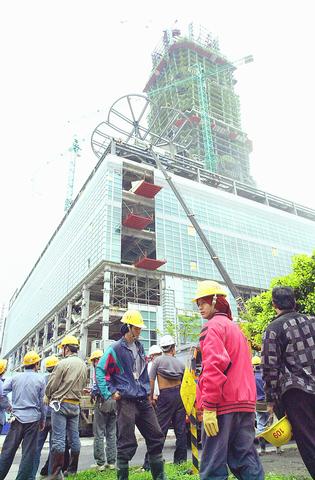Controversy has dogged the Taipei Financial Center ever since construction on the project began in 1999.
Concerns over the center's originally planned height of 508m put it under the national spotlight. Critics were concerned planes might crash into the building, even before the Sept. 11 attacks on the US.

PHOTO: GEORGE TSORNG, TAIPEI TIMES
The building's location near a fault line has also been a concern. Sunday's quake once again put the center back in the headlines.
Sunday's quake, which measured 6.8 on the Richter scale at its epicenter outside Haulien and 5 in Taipei, shook loose two cranes perched atop the 56th floor of the building. The cranes fell to the earth, killing five construction workers and injuring 20 others.
"Accompanied by Australian engineers [who arrived in Taiwan yesterday], the company is now inspecting the building to further understand the whole situation," Lin Chun-ju (林純如), spokeswoman for the Taipei Financial Center Corp, told the Taipei Times yesterday.
Taipei Financial Center Corp is the owner of the Taipei Financial Center project.
Prior to Sunday's disaster, concerns over fault lines, ground liquefaction and aviation safety have haunted the Taipei Financial Center project.
According to DPP Taipei City Councilor Yeh Hsin-yi (葉信義), the building is being built on an area that is subject to ground liquefaction that is also near a fault line.
"Based on these facts, I personally don't think the area is an appropriate site for a high-rise building," Yeh said.
The Taipei Financial Center -- which, it is hoped, will be the world's tallest building when completed -- is Taipei's first build-operate-transfer project as well the country's largest-ever architectural project.
The height of the building was originally planned to be much higher, but was lowered to 391.8m due to aviation safety concerns from the Civil Aeronautics Administration.
But the builders were later allowed to extend the building to its original height of 508m, after the administration loosened its aviation limitations earlier last month.
In addition to concerns over location and aviation issues, the building's construction plans have also been adjusted numerous times by the Taipei City Government's Bureau of Public Works after violations of construction safety measures.
"Of the 55 inspections we have conducted so far since construction started in 1999," said Shiao Shu-yen (
Originally scheduled to be completed by late next year, the completion date is now expected to be delayed as construction is being held up by the city government in the aftermath of Sunday's quake -- until safety inspections can be completed.
According to information from the Taipei Financial Center Corp, the building's gross floor area is 412,500m2, with 101 floors above ground and five floors underground.
Aside from shopping malls, restaurants and bars, the building will also feature an observation deck on the 89th floor and an outdoor one on the 91st floor.
Lin said the center will also be equipped with 61 elevators, including two that travel 1000m per minute, making it possible to reach the top floor in a mere 39 seconds.

Chinese Nationalist Party (KMT) Chairman Eric Chu (朱立倫), spokeswoman Yang Chih-yu (楊智伃) and Legislator Hsieh Lung-chieh (謝龍介) would be summoned by police for questioning for leading an illegal assembly on Thursday evening last week, Minister of the Interior Liu Shyh-fang (劉世芳) said today. The three KMT officials led an assembly outside the Taipei City Prosecutors’ Office, a restricted area where public assembly is not allowed, protesting the questioning of several KMT staff and searches of KMT headquarters and offices in a recall petition forgery case. Chu, Yang and Hsieh are all suspected of contravening the Assembly and Parade Act (集會遊行法) by holding

PRAISE: Japanese visitor Takashi Kubota said the Taiwanese temple architecture images showcased in the AI Art Gallery were the most impressive displays he saw Taiwan does not have an official pavilion at the World Expo in Osaka, Japan, because of its diplomatic predicament, but the government-backed Tech World pavilion is drawing interest with its unique recreations of works by Taiwanese artists. The pavilion features an artificial intelligence (AI)-based art gallery showcasing works of famous Taiwanese artists from the Japanese colonial period using innovative technologies. Among its main simulated displays are Eastern gouache paintings by Chen Chin (陳進), Lin Yu-shan (林玉山) and Kuo Hsueh-hu (郭雪湖), who were the three young Taiwanese painters selected for the East Asian Painting exhibition in 1927. Gouache is a water-based

Taiwan would welcome the return of Honduras as a diplomatic ally if its next president decides to make such a move, Minister of Foreign Affairs Lin Chia-lung (林佳龍) said yesterday. “Of course, we would welcome Honduras if they want to restore diplomatic ties with Taiwan after their elections,” Lin said at a meeting of the legislature’s Foreign Affairs and National Defense Committee, when asked to comment on statements made by two of the three Honduran presidential candidates during the presidential campaign in the Central American country. Taiwan is paying close attention to the region as a whole in the wake of a

OFF-TARGET: More than 30,000 participants were expected to take part in the Games next month, but only 6,550 foreign and 19,400 Taiwanese athletes have registered Taipei city councilors yesterday blasted the organizers of next month’s World Masters Games over sudden timetable and venue changes, which they said have caused thousands of participants to back out of the international sporting event, among other organizational issues. They also cited visa delays and political interference by China as reasons many foreign athletes are requesting refunds for the event, to be held from May 17 to 30. Jointly organized by the Taipei and New Taipei City governments, the games have been rocked by numerous controversies since preparations began in 2020. Taipei City Councilor Lin Yen-feng (林延鳳) said yesterday that new measures by